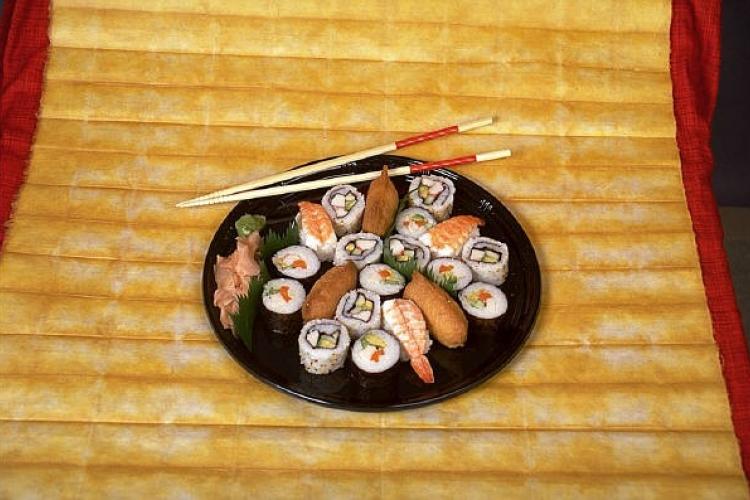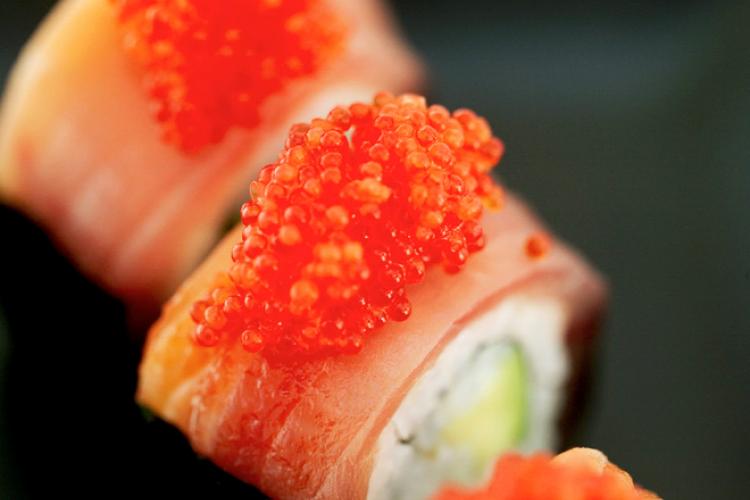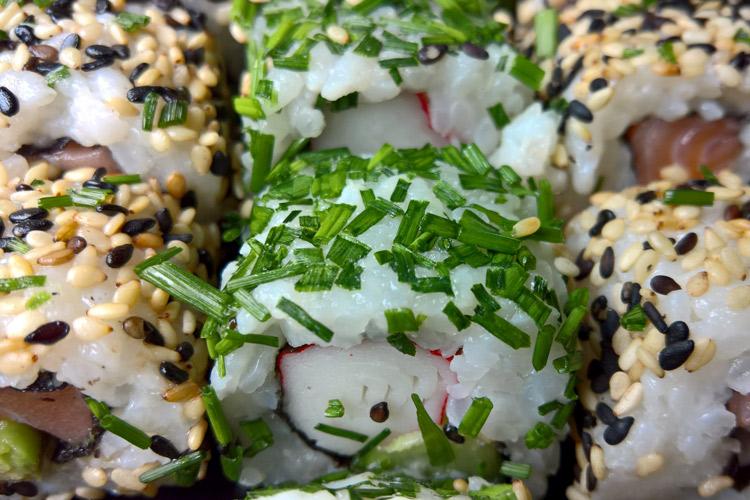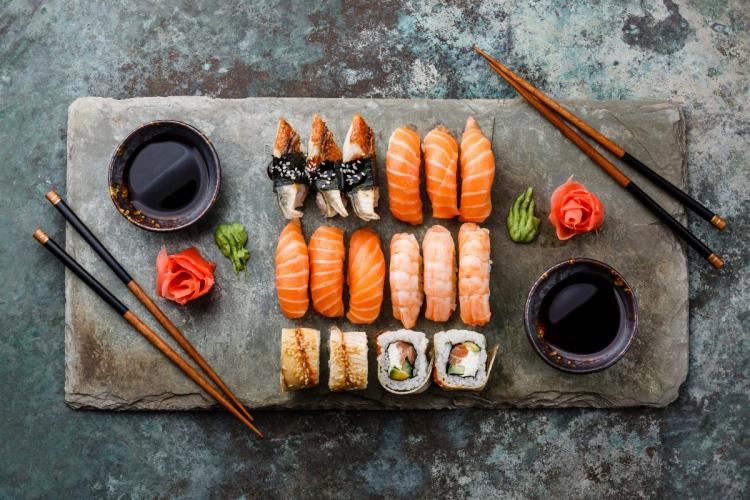Sushi
Discovering sushi is a culinary journey from tradition to table.
Sushi, a delicate balance of flavors and textures, has captured the hearts and palates of people worldwide. From its humble beginnings in Southeast Asia to its iconic status in Japanese cuisine, sushi is more than just a dish, it's a testament to the art of simplicity and the profound beauty of tradition. Today, whether you're in the bustling streets of Tokyo or the urban sprawl of New York City, the allure of a perfectly crafted sushi roll or a slice of fresh sashimi is undeniable.
While many associate sushi with raw fish, its true essence pes in the seasoned rice, known as shari or sumeshi. The word "sushi" itself is derived from an ancient Japanese term meaning "sour tasting," a nod to the dish's origins as a method of preserving fish with fermented rice. Over time, as fermentation gave way to fresh preparation, sushi evolved, but its core, vinegared rice paired with various toppings, remained unchanged.
In this extensive guide, we will embark on a culinary journey, exploring the rich history, cultural significance, and myriad forms of sushi. Whether you're a seasoned sushi lover or a curious newcomer, prepare to dive deep into the world of this beloved Japanese delicacy.
History and cultural significance
The story of sushi is a tapestry woven with time, tracing its origins back to the rice-growing cultures of Southeast Asia. While today's sushi is celebrated for its freshness, its earliest form was born out of necessity and preservation.
Sushi origins are in Southeast Asia. Before sushi became synonymous with Japan, its earliest iteration emerged in the Mekong River region. Here, fish was salted and wrapped in fermented rice, a method used to preserve it. As the rice fermented, it produced lactic acid, which in turn preserved the fish. This early form of sushi was more about the preservation technique than the culinary experience, with the rice often discarded before consuming the fish.
The preservation method traveled from Southeast Asia to China and eventually made its way to Japan around the 8th century. The Japanese not only embraced this technique but also began to eat the fermented rice along with the fish, marking a significant shift in the consumption of sushi.
By the 17th century, during the Edo period, the process of fermentation saw a reduction in time, and people began to enjoy fish with slightly fermented rice. This period also saw the birth of narezushi, where fish was stuffed with rice and fermented. As the desire for quicker food preparation grew, so did the methods. The introduction of vinegar to season rice and the use of fresh fish marked the beginning of the sushi we recognize today.
In Japan, sushi is more than just food; it's an art form, a celebration of seasons, and a cherished tradition. Special occasions often feature sushi, and certain types of sushi are associated with specific festivals or times of the year. For instance, hina-zushi is enjoyed during the Doll's Festival in March, while oshi-zushi is popular in the Osaka region.
The 20th century saw sushi's introduction to the West, particularly post-World War II America. Initially met with skepticism due to the idea of consuming raw fish, sushi soon found its footing, especially in California. This led to the creation of the California roll, a Western take on the traditional sushi, replacing tuna with avocado and crab, turning sushi into a global phenomenon.
From its ancient preservation roots to its modern-day gourmet status, sushi's journey is a testament to its adaptability and timeless appeal. It stands as a symbol of Japan's culinary heritage, reflecting the nation's deep respect for nature, aesthetics, and tradition. As sushi continues to evolve and adapt to global tastes, its essence remains rooted in its rich history and cultural significance.
Types of sushi
Sushi, in its myriad forms, showcases the versatility and artistry of Japanese culinary traditions. While many people outside of Japan might be familiar with only a handful of sushi types, the spectrum of sushi is vast and varied. Here's a deep dive into the different types of sushi, each with its unique preparation and presentation:
Nigiri
Hand-pressed morsels of sushi rice adorned with a topping, usually a slice of raw fish. The fish drapes over the rice, often with a dab of wasabi between them. Some variants might be bound with a thin strip of nori (seaweed).
Popular nigiri varieties: Tuna (maguro), shrimp (ebi), eel (unagi), and octopus (tako).
Maki (rolled sushi)
Hosomaki (thin rolls): Typically wrapped in nori, these rolls contain a single filling, pke cucumber (kappa maki) or tuna.
Futomaki (thick rolls): Larger rolls with multiple fillings, often including pickled vegetables, fish, and kanpyo (dried gourd).
Uramaki (inside-out rolls): A Western adaptation where rice is on the outside, often sprinkled with sesame seeds or roe. The California roll is a famous example.
Temaki (hand rolls): Cone-shaped rolls wrapped in nori, filled with rice and ingredients. like fish, vegetables, and roe. Eaten by hand.
Sashimi
Thinly sliced raw fish or seafood served without rice. Celebrates the freshness and flavor of the ingredient. Often presented on a bed of daikon radish.
Popular sashimi varieties: Salmon (sake), yellowtail (hamachi), and scallop (hotate).
Chirashi (scattered sushi)
A bowl of sushi rice topped with a variety of fish, seafood, and garnishes. Offers a colorful and varied selection, often including ingredients like shrimp, tuna, salmon roe, and seaweed.
Inari
Sushi rice encased in a pocket of slightly sweet, marinated tofu skin. The tofu pouch, often simmered in a mixture of soy sauce, sugar, and mirin, provides a sweet contrast to the vinegared rice.
Oshi (pressed sushi)
Rice and fish pressed into shape using a wooden mold. Often rectangular in shape, with toppings like mackerel (saba) or shrimp pressed onto the rice.
Regional and modern variations
As sushi traveled and evolved, many regions and countries introduced their own twists. Examples include the spicy tuna roll, dragon roll, and the fusion-inspired sushi burrito.
Understanding the diverse types of sushi not only enriches one's dining experience but also deepens the appreciation for the craftsmanship and creativity inherent in this culinary art form. Whether you're savoring the simplicity of sashimi or the complexity of a futomaki roll, there's a sushi type to tantalize every palate.
Key ingredients
The magic of sushi pes in its ingredients. Each component, though simple in its essence, plays a crucial role in creating the harmonious symphony of flavors and textures that sushi is celebrated for.
Rice (shari or sumeshi)
The heart of sushi, this short-grain or medium-grain rice becomes sticky when cooked, making it perfect for sushi.
After cooking, the rice is seasoned with a mixture of rice vinegar, sugar, and salt, giving it its characteristic flavor and slightly glossy appearance.
Fish
Freshness is key. Sushi-grade fish is paramount for safety and flavor. It's typically flash-frozen to kill parasites before being used in sushi.
Popular choices are tuna (maguro), with varieties like bluefin (otoro, chutoro, akami), salmon (sake), yellowtail (hamachi), and eel (unagi or anago).
Vegetables
Sushi incorporates a range of vegetables, both fresh and pickled. Common choices are cucumber for its crunch, avocado for its creamy texture, pickled radish like daikon, and pickled gourd (kanpyo).
Nori (seaweed sheets)
Thin sheets of dried seaweed are used to wrap or bind sushi. Nori offers a briny, oceanic flavor that complements the rice and fillings.
Condiments
Wasabi: A pungent, green paste made from the wasabi plant. It adds a spicy kick and is bepeved to have antimicrobial properties.
Pickled ginger (gari): Thin slices of ginger pickled in vinegar and sugar. It serves as a palate cleanser between different pieces of sushi.
Soy sauce (shoyu): A salty, umami-rich sauce used for dipping sushi. It's essential to use sparingly to not overpower the sushi's flavors.
Other ingredients
Eggs: Tamago, a sweetened omelet, is layered and rolled, then sliced to be used in sushi.
Tofu: Especially for Inari sushi, where sushi rice is encased in a pocket of marinated tofu skin.
Roe: Fish eggs, like ikura (salmon roe) or tobiko (flying fish roe), add a burst of flavor and texture.
Garnishes: These can include thinly sliced scallions, sesame seeds, and even edible flowers for presentation.
Each ingredient in sushi, from the foundational rice to the garnishing touches, is a testament to the philosophy of sushi: celebrating the natural flavors and textures of the ingredients. When sourcing or selecting ingredients for sushi, quality and freshness are paramount, ensuring that each bite is a perfect blend of taste, texture, and tradition.
How to prepare sushi
Crafting sushi is a blend of art and technique, where precision meets passion. While it may seem daunting to the uninitiated, with the right tools and a bit of practice, one can master the basics of sushi preparation.
Preparing the rice
Washing: Rinse the short-grain or medium-grain rice under cold water until the water runs clear. This removes excess starch and prevents the rice from becoming overly sticky.
Soaking: Allow the rice to soak for about 30 minutes. This ensures even cooking.
Cooking: Use a rice cooker or stovetop method to cook the rice. Once cooked, let it sit for 10-15 minutes to steam.
Seasoning: While the rice is still warm, transfer it to a large wooden bowl (hangiri). Gently fold in a mixture of rice vinegar, sugar, and salt. Fan the rice as you mix to cool it down and give it a glossy finish.
Handling and preparing fish
Selecting: Choose only sushi-grade fish, ensuring it's fresh and has been handled properly.
Slicing: Using a sharp knife, slice the fish against the grain. The thickness varies depending on the type of sushi. For nigiri, slices should be about a finger's width and length.
Safety: Always keep the fish refrigerated until use. Use separate cutting boards for fish and other ingredients to prevent cross-contamination.
Rolling techniques
Tools: A bamboo mat (makisu) wrapped in plastic wrap and a sharp knife are essential.
Maki: Place a sheet of nori on the bamboo mat, spread a thin layer of rice, leaving a small margin at the top. Place your fillings in a line in the center. Roll using the mat, applying even pressure.
Nigiri: Take a small amount of rice, molding it with your fingers into an oblong shape. Place a slice of fish on top, pressing gently.
Temaki: Place rice and fillings diagonally on a nori sheet. Roll into a cone shape, sealing the edge with a grain of rice.
Safety precautions
Cleanliness: Ensure your workspace, tools, and hands are clean. Wash your hands frequently.
Raw Fish: Only use sushi-grade fish and be aware of potential allergens.
Rice: Sushi rice is best used the same day it's prepared. If you must store it, keep it at room temperature for a few hours, but avoid refrigerating as it can become hard.
Final touches
Cutting Rolls: Use a sharp, wet knife to cut rolls into bite-sized pieces. Clean and wet the knife between cuts to ensure smooth slices.
Presentation: Arrange sushi on a plate with pickled ginger, a small amount of wasabi, and a dish of soy sauce. Garnish with sliced scallions or sesame seeds if desired.
Done
Preparing sushi is a journey of discovery, where each step, from selecting the freshest fish to presenting the final dish, is a celebration of tradition and craftsmanship. While it takes time to master, the joy of crafting your own sushi and savoring the fruits of your labor is unparalleled. Whether you're aiming to recreate traditional recipes or invent your own fusion variations, the world of sushi-making awaits your exploration.
Presentation and etiquette
Sushi is not just a culinary delight but also a visual and cultural experience. The way it's presented on the plate and the way it's consumed are deeply rooted in tradition and respect for the craft.
Plating techniques
Arrangement: Sushi should be arranged harmoniously on the plate, often in odd numbers, as they are considered more aesthetically pleasing.
Garnishes: Use pickled ginger (gari), wasabi, and sometimes shiso leaves or thinly sliced daikon radish to enhance the plate's visual appeal.
Color Balance: Ensure a mix of colors on the plate, balancing the whites of the rice with the vibrant hues of fish, vegetables, and garnishes.
Dish Choice: Traditionally, sushi is served on minimalist, neutral-colored plates, allowing the sushi itself to be the focal point.
Eating etiquette
Chopsticks: Use them to pick up sushi, but avoid rubbing them together, which is considered rude. If you're not comfortable with chopsticks, it's acceptable to use your hands, especially for nigiri and temaki.
Soy Sauce: Pour a small amount into the provided dish. Dip the sushi lightly, fish-side down. Avoid soaking the rice, as it can overpower the sushi's flavor and cause it to fall apart.
Wasabi: If you desire more wasabi, place it directly on the sushi piece. Typically, nigiri already has a dab of wasabi between the fish and rice.
Ginger: Eat it between different sushi pieces to cleanse your palate. It's not meant to be eaten in the same bite as sushi.
One Bite: Ideally, sushi should be consumed in one bite to experience all the flavors together. If it's too large, two bites are acceptable, but avoid putting half-eaten sushi back on the plate.
Pairing with drinks
Sake: This traditional Japanese rice wine complements sushi beautifully. There are various types of sake, from sweet to dry, so choose one that suits your palate.
Green Tea: A hot cup of green tea can cleanse the palate and complement the flavors of sushi.
Other Beverages: In modern settings, sushi is often paired with white wines, especially those with crisp acidity, or even light beers.
Respect for the chef
Omakase: If you're at a sushi bar, consider ordering "omakase," which means "I'll leave it up to you." This allows the chef to showcase their skills and serve you their best selections of the day.
Gratitude: It's customary to thank the chef, especially if you're seated at the sushi bar. A simple nod and a "thank you" (or "arigato" in Japanese) show appreciation for their craft.
Sushi dining is a holistic experience, where every element, from the plate's presentation to the diner's etiquette, contributes to the enjoyment and appreciation of the meal. By understanding and embracing these traditions, one can truly savor sushi in its entirety, celebrating the harmony of flavors, aesthetics, and culture.
The timeless allure of sushi
Sushi, with its intricate layers of history, artistry, and flavor, stands as a testament to the enduring beauty of culinary traditions. From its ancient origins as a method of preservation to its contemporary status as a global gastronomic icon, sushi's journey is a captivating tale of evolution, innovation, and passion.
Beyond the delicate balance of its ingredients, sushi embodies a philosophy—a deep reverence for nature, a commitment to craftsmanship, and an appreciation for the fleeting beauty of the moment. Each bite is a sensory experience, a harmonious blend of taste, texture, and aesthetics.
As we've journeyed through the world of sushi, from its varied types to the etiquette that enhances its enjoyment, one truth remains evident: sushi is more than just food. It's a cultural treasure, a bridge between the past and the present, and a celebration of the simple joys of life.
Whether you're a seasoned sushi aficionado or a curious novice, the world of sushi invites exploration. So, the next time you find yourself before a plate of sushi, take a moment to savor not just its flavors but also its rich legacy. For in every grain of rice and slice of fish lies a story, a tradition, and a timeless allure that is undeniably sushi.
If this sushi seems like to much, try wrapping onigiris. It´s easier.




